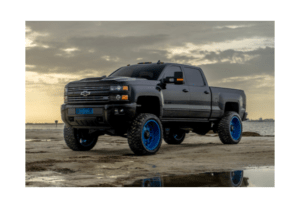A lot of new truck owners are looking to improve their trucks. They want to look and perform better on the road. Many of them want to install lift kits. Lift kits for trucks are a common modification on trucks these days. However, do they actually help or are they just a waste of money?
If you’re thinking about installing a lift kit on your truck or SUV, you might want to reconsider. There are certain risks with lift kits that aren’t worth taking — and it’s important that you know what they are before you make the decision to install one. Find out how risky lift kits can be for your vehicle, and make an informed decision about whether or not to take the risk for yourself.
In this article, we’re going to explore whether lift kits are bad for your truck and if they really do damage your vehicle. If you’re wondering whether you should install a lift kit, this guide will help you make an informed decision.
Jump to
What Is A Lift Kit?

The lift kit is a set of mechanical, electrical, and often hydraulic modifications to the base vehicle, with the purpose of elevating its ride height, typically to improve clearance for off-road terrain.
The goal is to increase the vehicle’s versatility and adaptability to different driving conditions. Lift kits are commonly installed to allow the vehicle to clear larger tires with ease. This can also help with traction and stability.
What Can Go Wrong With A Lift Kit on Truck?
- Vehicle handling can be negatively affected.
When you install a lift kit, you are changing the vehicle’s geometry. You’re making it longer and narrower, and it will affect the way the vehicle handles. You’ll notice that it becomes a little more sluggish, and you’ll lose some of the handling precision that you’ve come to expect.
- Vehicle fuel economy can be negatively affected
Since a vehicle’s fuel economy is tied directly to its aerodynamics, you can expect a loss in fuel economy when you install a lift kit. This is because lift kits tend to increase the amount of drag on the vehicle.
- The vehicle will lose some of its stability
When you install a lift kit, you’re increasing the vehicle’s length. The vehicle will have a longer wheelbase. The wheelbase is the distance between the front and rear axles. The longer the wheelbase, the more unstable the vehicle is. This is because the longer the wheelbase, the greater the distance between the front and rear axles.
Related Article – Are Lift Kits Bad for Trucks
Are There Other Risks Involved With A Lift Kit if installed on a Truck?
In addition to the handling issues, fuel economy loss, and vehicle stability, there are a few other risks you should be aware of before installing the best lift kit on your truck.
- Risk of undercarriage damage
When you add length to a vehicle, you’re adding weight to the vehicle’s undercarriage. This is because the undercarriage is the part of the vehicle that’s attached to the chassis. It’s the part that connects the frame to the wheels.
If you’re not careful, you can end up damaging the vehicle’s undercarriage when you install a lift kit. You should check the vehicle’s manual to see if there are any specific guidelines for installing a lift kit.
- Risk of damage to the suspension
Lift kits involve mechanical and electronic components that can easily cause damage to the suspension. Good-quality lift kits are designed to handle well-built suspensions. Lift kits involve mechanical and electronic components that can easily cause damage to the suspension. Good-quality lift kits are designed to handle well-built suspensions.
- Risk of damaged tires
The most obvious risk is that your tires are exposed to greater wear and tear. That’s because the stock tires were designed to fit underneath the original vehicle’s chassis. However, tires can be damaged during off-roading. This is why it is advised that you use tires specifically designed for off-road driving.
- Risk of losing control
If a truck is lifted with a lift kit then it is harder to control the vehicle. The steering will be affected because of the increased angle between the tires and the ground. The risk of rollover would also be increased due to the higher center of gravity.
The risk of the truck being damaged is significantly high because the center of gravity will be higher than a regular truck.
- Risk of gas tank puncture
If a lift kit is installed on a truck, then the vehicle can easily puncture the gas tank due to rough terrain. To avoid this, it’s crucial to install additional protection. A skid plate with additional reinforcement should do the trick.
How much maintenance is required after installing a lift kit?
The maintenance of a vehicle with a lift kit is exactly the same as a vehicle without a lift kit. Regular checkups at the service station are encouraged, but you will be able to perform the maintenance yourself by following the manufacturer’s guidelines:
- Changing the oil and oil filter
Transfer the oil drain plug and clean the drain hole before using it again. Replace any gasket or seal that may have been damaged. Replace the oil filter and a new crush washer.
This is a routine maintenance task that you should perform on a regular basis. However, if you don’t, you may damage the engine or transmission components. You should be sure to change the oil and oil filter when you perform regular maintenance.
- Checking and refilling the power steering fluid
The fluid reservoir is usually marked with a minimum and maximum levels. You must ensure that the fluid level is within these parameters. Power steering fluid should be changed every two years or 30,000 miles, depending on the vehicle model.
- Changing engine coolant
Check the level and in case of a low level or a change between high and low level, perform the replacement with the recommended coolant by the manufacturer. You must check your coolant regularly for signs of leaks, and change it as recommended by the manufacturer.
FAQ’s
1. How much should it cost to install a lift kit?
Outfitting your truck with a lift kit might seem like an intimidating DIY project. But it can also be quite affordable if you take the plunge and do it yourself – costing anywhere between $400 to $4000. If getting professional help is more up your alley, prices could range from as low as $800 all the way up to over twelve thousand dollars.
The biggest price variance is going to be how much your lift kit is raising your truck. Taller lift kits are going to cost you more.
2. How much is a 4 inch lift on a truck?
For those attempting more challenging projects, the cost of a suspension lift kit can vary hugely. Ranger from anywhere between $300 up to an incredible $15,000 – or even higher in some cases – depending on how much raise you need. From 2-5 inches will likely set you back around three grand but 6 inch and upwards is when it really starts costing serious money.
3. Do lift kits increase insurance?
Vehicle modifications can add a personal touch and value to your ride. However, it’s important to know that any changes done will likely result in higher insurance costs. Keep in mind you may need an additional policy endorsement when significant alterations are made – such as lift kits – for them to be covered by insurers.
4. What are the disadvantages of a lift kit?
Installing a lift kit can improve the look of your vehicle, but unfortunately it comes with some drawbacks. Frames are often more visible and gaps form in the fender wells after installation. Even worse is that factory bumpers remain unaffected by lifted bodies. If frame visibility makes you uneasy about going for a bigger ride height, then perhaps double-check your kit first before installing.
Final Thoughts on Lift Kits for Trucks
In this article, we discussed whether the lift kits are good or bad. To sum everything up, like any other modification to the car, a lift kit is both a blessing and a curse. The lift kits can, in fact, cause more damage than good. This is the reason why you should always do your homework before you start installing a lift kit.
The information you read should help you make a decision on whether or not you should install a lift kit. If you decide to install a lift kit, then it is important to make sure that you have all the information that you need.
We hope you enjoyed this guide. If you have any questions, feel free to ask. We will be happy to help you out with your confusion.

My name is Tom Harris, founder of this blog. I’m a mechanical engineer with 20 years of experience in the automotive industry. I’m here to help you with your vehicle’s problems, easy fixes and share my insights and experience so that you can enjoy your rides more.

